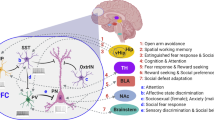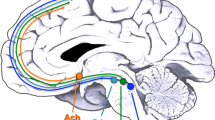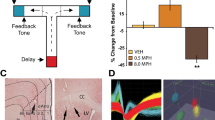Abstract
We used a novel computerized decision-making task to compare the decision-making behavior of chronic amphetamine abusers, chronic opiate abusers, and patients with focal lesions of orbital prefrontal cortex (PFC) or dorsolateral/medial PFC. We also assessed the effects of reducing central 5-hydroxytryptamine (5-HT) activity using a tryptophan-depleting amino acid drink in normal volunteers. Chronic amphetamine abusers showed sub-optimal decisions (correlated with years of abuse), and deliberated for significantly longer before making their choices. The opiate abusers exhibited only the second of these behavioral changes. Importantly, both sub-optimal choices and increased deliberation times were evident in the patients with damage to orbitofrontal PFC but not other sectors of PFC. Qualitatively, the performance of the subjects with lowered plasma tryptophan was similar to that associated with amphetamine abuse, consistent with recent reports of depleted 5-HT in the orbital regions of PFC of methamphetamine abusers. Overall, these data suggest that chronic amphetamine abusers show similar decision-making deficits to those seen after focal damage to orbitofrontal PFC. These deficits may reflect altered neuromodulation of the orbitofrontal PFC and interconnected limbic-striatal systems by both the ascending 5-HT and mesocortical dopamine (DA) projections.
Similar content being viewed by others
Log in or create a free account to read this content
Gain free access to this article, as well as selected content from this journal and more on nature.com
or
References
Alexander GE, DeLong MR, Strick PL . (1986): Parallel organisation of functionally segregated circuits linking the basal ganglia and cortex. Annu Rev Neurosci 9: 357–381
Arnsten AFT . (1997): Catecholamine regulation of the prefrontal cortex. J Psychopharm 11: 151–162
Axt KJ, Molliver ME . (1991): Immunocytochemical evidence for methamphetamine-induced serotonergic axon loss in the rat brain. Synapse 9: 302–313
Bechara A, Damasio AR, Damasio H, Anderson SW . (1994): Insensitivity to future consequences following damage to human prefrontal cortex. Cognition 50: 7–15
Bechara A, Tranel D, Damasio H, Damasio AR . (1996): Failure to respond autonomically to anticipated future outcomes following damage to prefrontal cortex. Cerebral Cortex 6: 215–225
Bechara A, Damasio H, Tranel D, Damasio AR . (1997): Deciding advantageously before knowing the advantageous strategy. Science 275: 1293–1295
Bechara A, Damasio H, Tranel D, Anderson SW . (1998): Dissociation of working memory from decision-making within human prefrontal cortex. J Neurosci 18 (1): 428–437
Bowen FP, Kamienny MA, Burns M, Yahr MD . (1975): Parkinsonism: Effects of levodopa on concept formation. Neurology 25: 701–704
Brozoski TJ, Brown R, Rosvold HE, Goldman PS . (1979): Cognitive deficit caused by regional depletion of dopamine in prefrontal cortex of rhesus monkeys. Science 205: 929–931
Cloninger CR, Bohman M, Sigvardsson S . (1981): Inheritance of alcohol abuse. Arch Gen Psychiatry 38: 861–868
Cloninger CR . (1987): Neurogenetic adaptive mechanisms in alcoholism. Science 236: 410–416
Cloninger CR . (1994): Temperament and personality. Curr Opin Neurobiol 4: 266–273
Damasio AR . (1994): Descartes’ Error, New York: Grosset/Putnam
Damasio AR . (1996): The somatic marker hypothesis and the possible functions of the prefrontal cortex. Phil Trans R Soc Lond B 351: 1413–1420
Daniel DG, Weinberger DR, Jones DW, Zigun JR, Cippola R, Handel S, Bigelow LB, Goldberg TE, Berman KF, Kleinman JE . (1991): The effect of amphetamine on regional cerebral blood flow during cognitive activation in schizophrenia. J Neurosci 11: 1907–1917
DiChiara G, Imperato A . (1988): Drugs abused by humans preferentially increase synaptic dopamine concentrations in the mesolimbic system of freely moving rats. Proc Natl Acad Sci 85: 5274–5278
Downes JJ, Roberts AC, Sahakian BJ, Evenden JL, Morris RG, Robbins TW . (1989): Impaired extra-dimensional shift performance in medicated and unmedicated Parkinson's disease: Evidence for a specific attentional dysfunction. Neuropsychologia 27: 1329–1343
Eslinger PJ, Damasio AR . (1985): Severe disturbance of higher cognition after bilateral frontal lobe ablation: Patient EVR. Neurology 35: 1731–1741
Fishbein DH, Lozovsky D, Jaffe JH . (1988): Impulsivity, aggression, and neuroendocrine response to serotonergic stimulation in substance abusers. Biol Psychiatry 25: 1049–1066
Freedman M, Oscar-Berman M . (1996): Bilateral frontal lobe disease and selective delayed response deficits in humans. Behav Neursci 100: 337–342
Fukui K, Nakajima T, Kariyama H, Kashiba A, Kato N, Tohyama I, Kimura H . (1989): Selective reduction of serotonin immunoreactivity in some forebrain regions of rats induced by acute methamphetamine treatment: Quantitative morphometric analysis by serotonin immunocytochemistry. Brain Res 482: 198–203
Gibb JW, Hanson GR, Johnson M . (1994): Neurochemical mechanisms of toxicity. In Cho AK, Segal DS (eds), Amphetamine and its Analogs. San Diego, Academic
Groenewegen HJ, Wright CI, Uylings HBM . (1997): The anatomical relationships of the prefrontal cortex with limbic structures and the basal ganglia. J Psychopharm 11: 99–106
Hotchkiss AJ, Gibb JW . (1980): Long-term effects of multiple doses of methamphetamine on tryptophan hydroxylase and tyrosine hydroxylase activity in rat brain. J Pharmacol Exp Ther 214: 257–262
Howell DC . (1987): Statistical Methods for Psychology, 2nd ed. Boston, Duxbury Press
Knowlton BJ, Mangels JA, Squire LS . (1996): A neostriatal habit learning system in humans. Science 273: 1399–1402
Koob GF, Bloom FE . (1988): Cellular and molecular mechanisms of drug dependence. Science 242: 715–723
Lacey JH, Evans CHD . (1986): The impulsivist: A multi-impulsive personality disorder. Br J Addiction 81: 641–649
Lange KW, Robbins TW, Marsden CD, James M, Owen AM, Paul GM . (1992): L-Dopa withdrawal in Parkinson's disease selectively impairs performance in tests sensitive to frontal lobe dysfunction. Psychopharmacology 107: 394–404
Linnoila M, Virkkunen M, Stein M, Nuptial A, Ripon R, Goodwill FK . (1983): Low cerebrospinal fluid 5-hydroxyindoleacetic acid differentiates impulsive from nonimpulsive violent behavior. Life Sci 33: 2609–2614
Linnoila M, DeJong J, Virkkunen M . (1989): Family history of alcoholism in violent offenders and impulsive fire setters. Arch Gen Psychiatry 46: 613–616
McCown W . (1988): Multi-impulsive personality disorder and multiple substance abuse: Evidence from members of self-help groups. Br J Addiction 83: 431–432
McGown W . (1990): The effect of impulsivity and empathy on abstinence of poly-substance abusers: A prospective study. Br J Addiction 85: 635–637
Mansour A, Khachaturian H, Lewis ME, Akil H, Watson SJ . (1988): Anatomy of CNS opioid receptors. Trends Neurosci 11: 308–314
Melega WP, Quintana J, Raleigh MJ, Stout DB, Yu DC, Lin KP, Huang SC, Phelps ME . (1996): 6-[18F]fluoro-[sca]1-DOPA-PET studies show partial reversibility of long-term effects of chronic amphetamine in monkeys. Synapse 22: 63–69
Miller LA . (1992): Impulsivity, risk-taking, and the ability to synthesize fragmented information after frontal lobectomy. Neuropsychologia 30: 69–79
Milner B . (1964): Some effects of frontal lobectomy in man. In Warren JM, Akert K (eds), The Frontal Granular Cortex and Behavior. New York, McGraw-Hill
Nace EP, Saxon JJ, Shore N . (1983): A comparison of borderline and nonborderline alcoholic patients. Arch Gen Psychiatry 40: 54–56
Nelson HE . (1982): National Adult Reading Test (NART) Test Manual. Windsor (UK), NFER-Nelson
Owen AM, Roberts AC, Polkey CE, Sahakian BJ, Robbins TW . (1991): Extra-dimensional versus intra-dimensional set shifting performance following frontal lobe excision, temporal lobe excision or amygdalo-hippocampectomy in man. Neuropsychologia 29: 993–1006
Park S, Holzman PS . (1992): Schizophrenics show spatial working memory deficits. Arch Gen Psychiatry 49: 975–982
Piazza PV, Deminierre J-M, Le Moal M, Simon H . (1989): Factors that predict individual vulnerability to amphetamine self-administration. Science 245: 1511–1513
Piazza PV, Maccari S, Deminierre J-M, Le Moal M, Mormede P, Simon H . (1991): Corticosterone levels determine individual vulnerability to amphetamine self-administration. Proc Natl Acad Sci 88: 2088–2092
Piazza PV, Deroche V, Deminierre J-M, Maccari S, Le Moal M, Simon H . (1993): Corticosterone in the range of stress-induced levels possesses reinforcing properties: Implications for sensation-seeking behaviors. Proc Natl Acad Sci 90: 11738–11742
Preston KL, Wagner GC, Schuster CR, Seiden LS . (1985): Long-term effects of repeated methylamphetamine administration on monoamine neurons in the rhesus monkey brain. Brain Res 338: 243–248
Raleigh M, McGuire M, Melega W, Cherry S, Huang S-C, Phelps M . (1996): Neural mechanisms supporting social decisions in simians. In Damasio AR (ed), Neurobiology of Decision-making. Berlin, Heidelberg, Springer-Verlag
Ricaurte GA, Schuster CR, Seiden LS . (1980): Long-term effects of repeated methylamphetamine administration on dopamine and serotonin neurons in the rat brain: A regional study. Brain Res 193: 153–163
Ricaurte GA, Schuster CR, Seiden LS . (1984): Further evidence that amphetamines produce long-lasting dopamine neurochemical deficits by destroying dopamine nerve fibers. Brain Res 303: 359–364
Robbins TW, Roberts AC, Owen AM, Sahakian BJ, Everitt BJ, Muir J, De Salvia M, Tovée M . (1994): Monoaminergic-dependent cognitive functions of the prefrontal cortex in monkeys and man. In Thierry AM (ed), Motor and Cognitive Functions of the Prefrontal Cortex . Berlin, Heidelberg, Springer-Verlag
Robinson TE, Becker JB . (1986): Enduring changes in brain and behavior produced by chronic amphetamine administration: A review and evaluation of animal models of amphetamine psychosis. Brain Behav Res 11: 157–198
Ryan LJ, Martone ME, Linder JC, Groves PM . (1988): Cocaine, in contrast to d-amphetamine, does not cause axonal terminal degeneration in neostriatum and agranular cortex of Long-Evans rats. Life Sci 43: 1403–1409
Ryan LJ, Linder JC, Martone ME, Groves PM . (1990): Histological and ultrastructural evidence that d-amphetamine causes degeneration in neostriatum and frontal cortex of rats. Brain Res 518: 67–77
Saver JL, Damasio AR . (1991): Preserved access and processing of social knowledge in a patient with acquired sociopathy due to ventromedial frontal damage. Neuropsychologia 29: 1241–1249
Sawaguchi T, Goldman-Rakic PS . (1991): D1 dopamine receptors in prefrontal cortex: Role in working memory. Science 252: 947–950
Seiden LS, Fischman MW, Schuster CR . (1975): Long-term methamphetamine induced changes in brain catecholamine in tolerant rhesus monkeys. Drug Alcohol Depend 1: 215–219
Seiden LS, Ricaurte GA . (1987): Neurotoxicity of methamphetamine and related drugs. In Meltzer H (ed), Psychopharmacology: The Third Generation of Progress. New York, Raven Press
Shallice T, Evans ME . (1978): The involvement of the frontal lobes in cognitive estimation. Cortex 14: 294–303
Thierry AM, Blanc G, Sobel A, Stinus L, Glowinski J . (1973): Dopamine terminals in the rat cortex. Science 182: 499–501
Villemagne V, Yuan J, Wong DF, Dannals RF, Hatzidimitriou G, Mathews WB, Hayden TR, Musachio J, McCann UD, Ricaurte GA . (1998): Brain dopamine neurotoxicity in baboons treated with methamphetamine comparable to those used recreationally abused by humans: Evidence from [11C]WIN-35,428 positron emission tomography studies and direct in vitro determinations. J Neurosci 18 (1): 419–433
Virkkunen M, Rawlings R, Tokola R, Poland RE, Guidotti A, Nemeroff C, Bissette G, Kalogeras K, Karonen SL, Linnoila M . (1994): CSF biochemistries, glucose metabolism, and diurnal activity rhythms in alcoholic, violent offenders, fire setters, and healthy volunteers. Arch Gen Psychiatry 51: 20–27
Volkow ND, Mullani N, Lance Gould K, Adler S, Krajewski K . (1988): Cerebral blood flow in chronic cocaine users: A study with positron emission tomography. Br J Psychiatry 152: 648–651
Volkow ND, Fowler JS, Wolf AP, Hitzemann R, Dewey SL, Bendreim B, Alpert R, Hoff A . (1991): Changes in brain glucose metabolism in cocaine dependence and withdrawal. Am J Psychiatry 148: 621–627
Volkow ND, Fowler JS, Wang GJ, Hitzemann R, Logan J, Schyler DJ, Dewey SL, Wolf A . (1993): Decreased dopamine D2 receptor availability is associated with reduced frontal metabolism in cocaine abusers. Synapse 14: 169–177
Volkow ND, Wang GJ, Fowler JS, Logan J, Gatley SJ, Hitzemann R, Chen AD, Dewey SL, Pappas N . (1997): Decreased striatal dopaminergic responsiveness in detoxified cocaine-dependent subjects. Nature 386: 830–833
Wagner GC, Ricaurte GA, Seiden LS, Schuster CR, Miller RJ, Westley J . (1980): Long-lasting depletions of striatal dopamine and loss of dopamine uptake sites following repeated administration of methamphetamine. Brain Res 181: 151–160
Wilson JM, Norbrega JN, Carroll ME, Niznik HB, Shannak K, Lac ST, Pristupa ZB, Dixon LM, Kish SJ . (1991): Heterogenous subregional binding patterns of 3H-WIN 35,428 and 3H-GBR 12,935 are differentially regulated by chronic cocaine self-administration. J Neurosci 14: 2966–2979
Wilson JM, Kalasinksky KS, Levey AI, Bergeron C, Reiber G, Anthony RM, Schmunk GA, Shannak K, Haycock JW, Kish SJ . (1996a): Striatal dopamine nerve terminal markers in human chronic methamphetamine users. Nature Medicine 2: 699–703
Wilson JM, Levey AI, Bergeron C, Kalasinksky KS, Lee Ang, Peretti F, Adams VI, Smialek J, Anderson WR, Shannak K, Deck J, Niznik HB, Kish SJ . (1996b): Striatal dopamine, dopamine transporter, and vesicular monoamine transporter in chronic cocaine users. Ann Neurol 40: 428–439
Wise RA, Rompré PP . (1989): Brain dopamine and reward. Ann Rev Psychol 40: 191–225
Woolverton WL, Ricaurte GA, Forno LS, Seiden LS . (1989): Long-term effects of chronic methamphetamine administration in rhesus monkeys. Brain Res 486: 73–78
Young SN, Smith SE, Pihl RO, Ervin FR . (1985): Tryptophan depletion causes a rapid lowering of mood in normal males. Psychopharmacology 87: 173–177
Acknowledgements
This research was supported by a Programme Grant from the Wellcome Trust to T. W. Robbins, B. J. Everitt, A. C. Roberts, and B. J. Sahakian, and an MRC studentship to Rachel Swainson. The tryptophan depletion study was funded by the development program of Neuraxis Ltd., Skelton House, Manchester Science Park, Lloyds Street North, Manchester, M15 6SH, United Kingdom, and organized and devised with the help of John Connell, Chris Mortimer, and Ian Anderson. This work was completed within the MRC Co-operative in Brain, Behaviour and Neuropsychiatry.
Author information
Authors and Affiliations
Rights and permissions
About this article
Cite this article
Rogers, R., Everitt, B., Baldacchino, A. et al. Dissociable Deficits in the Decision-Making Cognition of Chronic Amphetamine Abusers, Opiate Abusers, Patients with Focal Damage to Prefrontal Cortex, and Tryptophan-Depleted Normal Volunteers: Evidence for Monoaminergic Mechanisms. Neuropsychopharmacol 20, 322–339 (1999). https://doi.org/10.1016/S0893-133X(98)00091-8
Received:
Revised:
Accepted:
Issue date:
DOI: https://doi.org/10.1016/S0893-133X(98)00091-8
Keywords
This article is cited by
-
Suboptimal decision making and interpersonal problems in ADHD: longitudinal evidence from a laboratory task
Scientific Reports (2024)
-
Features of Decision-Making in Patients with Alcohol Dependence
Neuroscience and Behavioral Physiology (2024)
-
Impaired Outcome Evaluation During Risky Decision-Making in Individuals with Methamphetamine Use Disorder
International Journal of Mental Health and Addiction (2024)
-
Polygenic contributions to performance on the Balloon Analogue Risk Task
Molecular Psychiatry (2023)
-
A Systematic Review of Sex/Gender Differences in the Multi-dimensional Neurobiological Mechanisms in Addiction and Their Relevance to Impulsivity
Current Addiction Reports (2023)



